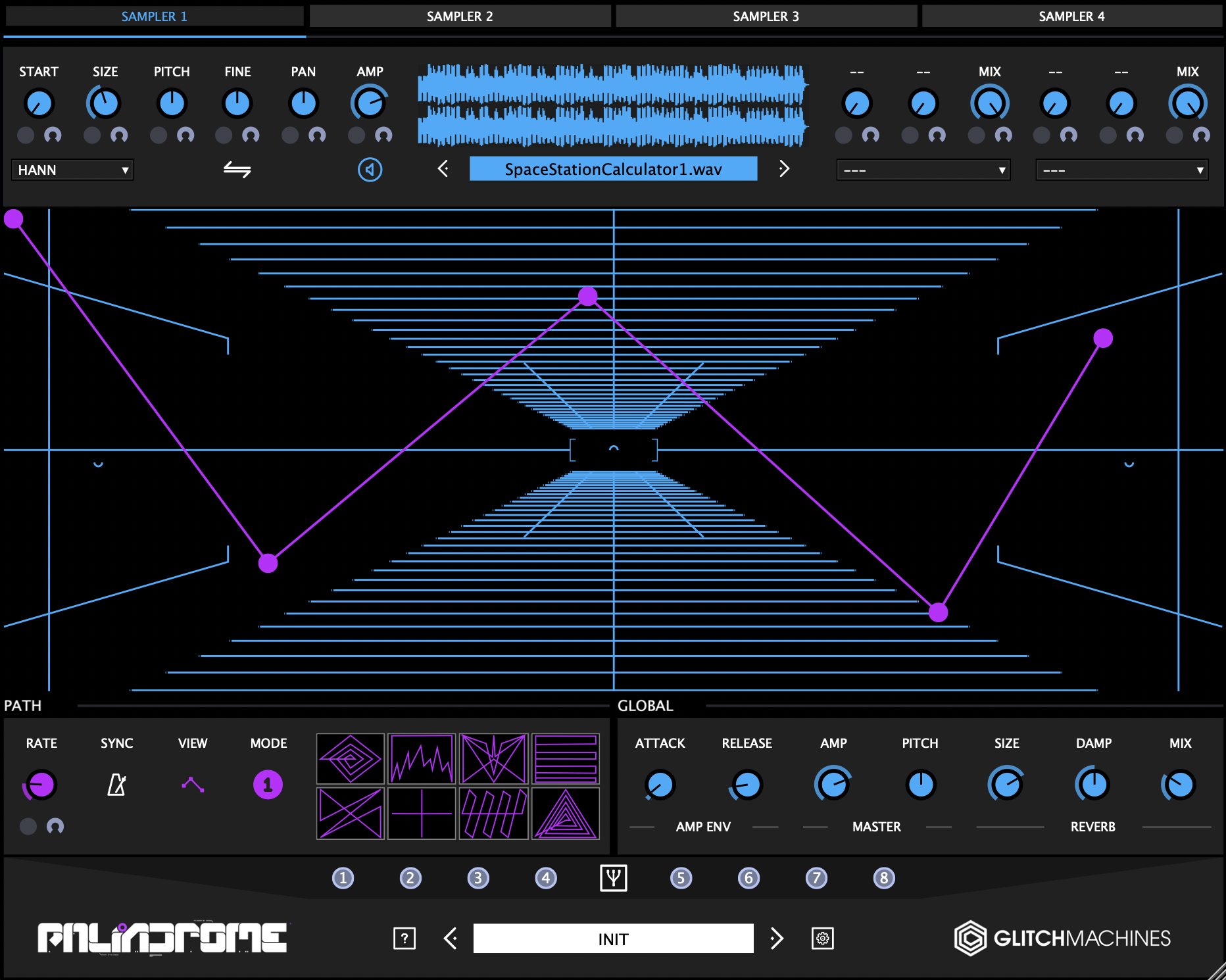PALINDROME Review
*Below is my review for the original version of Palindrome, most of this information still applies, but you can read my review of the updated features here: https://www.databroth.com/blog/palindrome-2-update-review
Glitch machine’s Palindrome is quite an intimidating looking synth, looking like something straight out of tempest, the vector based ui might be overwhelming. Once you get past the initial beginners curve,it turns out to be a fair bit simpler than it looks. Palindrome features 4 layers, each with a basic loop based granular engine, and 2 inset effects. The large XY area is used to intuitively draw a path between each part, blending between the 4 sounds. This is not a bread and butter synth, while it’s possible to make basses and leads on nearly anything, Palindrome feels a lot more like an experimental sound design playground.
OSCILLATORS: The oscillators in palindrome are dead simple, you load a sample, and set a loop length and start position. There are a couple window shapes to choose from, but the purpose of these oscs is to create texture. The sound of Palindrome is fairly dry, the loop regions click, but don’t overpower the rest of the audio, as the developer’s name suggests, this is in fact a glitch machine. You can modulate all the controls here with start and loop being some of the more fun to add motion to, creating evolving textures and rhythms. The magic really comes in when you have 4 of these layers going, you can explore the various mixes of layers via the XY grid, and draw out a motion through these regions for Palindrome to automatically travel through.
Palindrome is polyphonic, so if you load tonal sounds into the four layers you can actually create playable instruments.
EFFECTS: Each Layer has 2 insert effects, which include some basic filters to shape the tone of each layer. There’s also a distortion and wave folder for adding grit, and lastly ring mod and delay. The ring mod and fold give a much needed element of sound design to play with, but the delay is where things get pretty fun. You can set the delay time fairly short and introduce feedback for more combed type sounds, modulate this for flangers to add some extra dimension. As mentioned, these effects are per layer, meaning the vector pathway fades between them.
MODULATION: Palindrome is built around modulation, if everything has seemed too simple so far, the vector modulation really adds a dimension of complexity to this instrument. First off is the main vector pathing, you can draw nodes which form a path between each of the 4 regions, this path is followed automatically on new key presses. There’s a couple loop modes to pick from and even a random mode, where the path will travel from one node to another randomly selected node.
Next is the vector modulation, there’s a total of 8 drawable vector modulators, which can be tempo synced or looped. These allow you to add motion to the grain engine or effects, and when creating complex shapes you can really get a lot of chaos out of everything.
RANDOMIZATION: Glitch Machine plugins always incorporate some sort of randomizer into the workflow. I’m not a huge fan of these, but they can be fun for beginners or for when you just don’t have any ideas.
Click randomize a few times until something cool pops out, sample it, and play. Palindrome takes this concept a step up by allowing you to randomize various sections of the plugin. You can randomize just the samples, or just the envelopes, or if you want, absolutely everything.
Palindrome is likely my favorite of all the Glitch Machines devices, it’s quite unique and fun to play with and it has a good amount of character. As with anything, you “can” do this with enough samplers and automation, but that REALLY takes the joy out the process. I think the idea here is to load in a few samples and just play around until you get something fun. I like to use Palindrome to create abstract glitchy textures, especially if I don’t need things to be “musical” or tied to the grid, or if I want something a bit more rough around the edges
Also the bold almost neon retro looking UI really fits here, this is a tool for play and exploration, create a bunch of presets, use it ot feed other effects, resample, repeat. There’s no need to think of every synth in terms of leads and bass lines, sometimes it’s nice to have something for generating weird sound scapes. You never know when you’ll come across that weird moment that sparks an idea for a full track.
If you plan on purchasing Palindrome from Plugin Boutique, please consider supporting me by using my affiliate links
PALINDROME 2: https://www.pluginboutique.com/product/1-Instruments/5-Sampler/11925-Palindrome-2-0?a_aid=61c378ab215d5
UPGRADE: https://www.pluginboutique.com/product/1-Instruments/5-Sampler/11926-Palindrome-2-0-Upgrade-from-Palindrome-1?a_aid=61c378ab215d5



